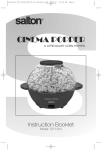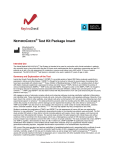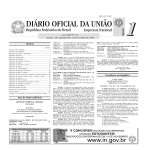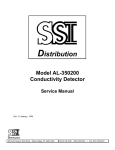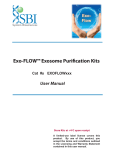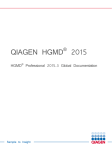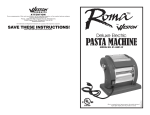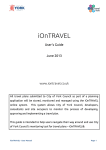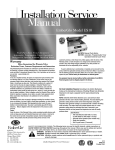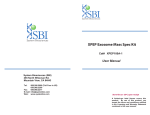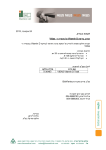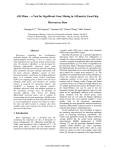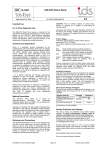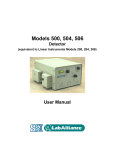Download Précautions d`utilisation du produit :
Transcript
REF IS-2400 Instructions for Use IDS-iSYS 1,25 Dihydroxy Vitamin D IN VITRO DIAGNOSTIC a gentle flow of nitrogen at 40°C and reconstituted in 200 μL assay buffer. Intended Use For In Vitro Diagnostic Use The IDS-iSYS 1,25-Dihydroxy Vitamin D kit is a complete assay system intended for the purification of 1,25-dihydroxyvitamin D [1,25D] in human serum or plasma by immunopurification followed by quantitative determination on the IDS-iSYS Multi-Discipline Automated System [System] to assess 1,25-dihydroxyvitamin D deficiency associated with renal disease. Results are to be used in conjunction with other clinical and laboratory data to assist the clinician in making patient management decisions. Summary and Explanation There are two forms of vitamin D: vitamin D3 and vitamin D2. Vitamin D3, cholecalciferol, is the naturally occurring vitamin D that is produced in the skin after exposure of 7-dehydrocholesterol to solar ultraviolet radiation (1). Vitamin D2 is manufactured through the ultraviolet irradiation of ergosterol from yeast. Both are used in vitamin D supplements. The vitamin D compound is biologically inactive, but enters the circulation and is hydroxylated in the liver to 25-hydroxyvitamin D [25D], which is used to determine a patient’s vitamin D status. In the kidney, 25D is further hydroxylated to produce biologically active metabolite, 1,25-dihydroxyvitamin D [1,25D] (1). 1,25D is one of the major regulators of calcium and phosphate metabolism, stimulating intestinal calcium absorption and increasing bone resorption. It also inhibits parathyroid hormone (PTH) production both by direct action on the parathyroid glands and indirectly by raising serum calcium levels. 1,25D production is itself stimulated by parathyroid hormone (PTH), thus providing an effective control loop (1). Fibroblast growth factor 23 [FGF-23], secreted from the bone, causes the sodium–phosphate cotransporter to be internalized by the cells of the kidney and small intestine and also suppresses 1,25D synthesis (2). In secondary hyperparathyroidism, a disease outside of the parathyroids causes all of the parathyroid glands to become enlarged and hyperactive. It is usually caused by kidney failure, a problem where the kidney is unable to clean the blood of phosphorus produced by the body and unable to make enough vitamin D, specifically 1,25D - the active form of vitamin D. The build-up of phosphorous leads to low levels of calcium in the blood, which stimulates the parathyroid glands to increase parathyroid hormone (PTH) production leading to the glands to enlarge. As the disease progresses, the parathyroid glands no longer respond normally to calcium and Vitamin D. The rationale for direct activated vitamin D therapy in CKD is to slow the progression of secondary hyperparathyroidism. The clinical practice guidelines such as the Kidney Disease Outcomes Quality Initiatives (KDOQI), and the Kidney Disease: Improving Global Outcomes (KDIGO) recommend activated vitamin D therapeutic regimens for CKD patients (3,4). Method Description The IDS-iSYS 1,25-Dihydroxy Vitamin D kit is a complete assay system for the purification of 1,25D in patient samples by immunopurification followed by quantitation by one-site chemiluminescent immunoassay on the automated IDS-iSYS instrument. 150μL delipidated sample is added to an immunocapsule which contains a gel containing a monoclonal anti-1,25D antibody. 90 minutes rotation of the immunocapsule allows the binding of 1,25D to the monoclonal antibody. The gel is washed to remove potential interfering substances and the 1,25D eluted with ethanol. Eluates are then evaporated under IS-2400PLv02, 2012-06-11, English Page 1/5 The reconstituted immunopurified samples are placed into the IDS-iSYS sample rack; the sample rack is then loaded on the IDS-iSYS system. 120 μL of the reconstituted immunopurified samples are incubated with the biotinylated sheep anti-1,25D antibody. The 1,25D-Acridinium conjugate is then added which competes for antibody binding sites. Streptavidin coated magnetic particles are then added and following a further incubation step, the particles are washed to remove unbound materials. Following the addition of Trigger Reagents, a flash chemiluminescent reaction is initiated. The light signal is measured by the photomultiplier as Relative Light Units (RLU) and is inversely proportional to the amount of 1,25D present in the samples. Warnings and Precautions The IDS-iSYS 1,25-Dihydroxy Vitamin D kit is for in vitro diagnostic use only and is not for internal use in humans or animals. This product must be used strictly in accordance with the instructions set out in these Instructions for Use (IFU). IDS Limited will not be held responsible for any loss or damage (except as required by statute), howsoever caused arising out of non-compliance with the instructions provided. CAUTION: This kit contains material of animal origin. Handle kit reagents as if capable of transmitting an infectious agent. Appropriate precautions and good laboratory practice must be used in the storage, handling and disposal of the kit reagents. Disposal of kit reagents should be in accordance with local regulations. Sodium Azide Xn. Harmful: Calibrators contain sodium azide (NaN3) >0.1% (w/w) (<1%). R22 Wear suitable protective clothing and gloves. R52/53 Harmful to aquatic organisms, may cause long-term adverse effects in the aquatic environment. S46 If swallowed, seek medical advice immediately and show this container or label. S36/37 Wear suitable protective clothing and gloves. S60 This material and/or its container must be disposed of as hazardous waste. Some reagents in this kit contain sodium azide which may react with lead, copper or brass plumbing to form highly explosive metal azides. On disposal, flush with large volumes of water to prevent azide build up. Elution Reagent Elution reagent contains ethanol. R11 Highly flammable (flashpoint 13oC). S7 Keep container tightly closed. S16 Keep away from sources of ignition – No smoking. Handling Precautions Apart from the calibrators which are lyophilised, the reagents provided in the kit are ready to use. Refer to the calibrator section of the procedure for reconstitution methodology. Before a new cartridge is loaded onto the IDS-iSYS system, mix the magnetic particles container by a brisk rotation motion. This will resuspend the magnetic particles that have settled during shipment. Ensure that there is no foam formation in the cartridge reagents. Should this occur, store the cartridge in an upright position in the dark at 2 to 8 °C until foaming has dissipated. Device code: IS-2400 IDS-iSYS 1,25 Dihydroxy Vitamin D REF IS-2400 Instructions for Use IN VITRO DIAGNOSTIC Reagent Cartridge Shelf Life and Storage of Reagents Prior to first use, store the cartridge and the calibrators in an upright position in the dark at 2 to 8 °C. Do not freeze the cartridge. Reagent shelf life Before opening at 2 - 8 °C Cartridge, After opening at 2 - 8 °C On board the IDS-iSYS * Cartridge Calibrators To the expiry date 49 Days N/A 49 Days 3 Hours N/A 6 Hours N/A 28 Days N/A 2 Calibrators, After reconstitution at 2-8°C Calibrators, After reconstitution at -20 °C or lower Calibrators, Freeze/thaw cycle(s) CONJ Conjugate, 1,25D labelled with an acridinium ester derivative, in a phosphate buffer containing bovine serum albumin with sodium azide as preservative (<0.1%), 1 cartridge vial, 9.6 mL per vial. Ab-BIOT Antibody-Biotin, Anti-1,25D polyclonal antibody labelled with biotin, in a phosphate buffer containing sheep proteins with 0.01% sodium azide as preservative, 1 cartridge vial, 13mL per vial. BUFD Wash buffer, 1% proprietary detergent in PBS azide, 1 cartridge vial, 35mL per vial. * Continuous on board stability. Sample Collection and Storage The assay should be performed using serum (standard sampling tubes or tubes containing serum separating gel) or plasma (lithium heparin, sodium heparin or potassium EDTA) samples. Samples should be separated as soon as possible after collection. Calibrators Samples Storage Stability Duration CAL A CAL B Lyophilised MOPS buffer containing bovine serum albumin, 1,25D and sodium azide as preservative (<1.0%), 2 each of 2 concentration levels, 1.2mL. Room temperature 24 Hours Mini CD 2 - 8 °C 7 Contains IFU for IDS-iSYS 1,25D reagents and CRY files. -20 °C or lower 2.5 Months Freeze/thaw cycles 2 Days Materials Required But Not Provided To minimise possible evaporation effects, reconstituted calibrators should be measured within 3 hours and reconstituted immunopurified samples within 90 minutes after being placed on the system. It is recommended to follow the instructions of the tube manufacturer especially when processing samples in primary tubes. NOTE: i. MP Magnetic particles coated with streptavidin in a phosphate buffer containing bovine serum albumin and sodium azide as preservative (<0.1%), 1 vial, 2.6 mL per vial. Some sample collection tubes that are commercially available might affect the results of testing in particular cases. Procedure Materials Provided IDS-iSYS Multi-Discipline Automated System: IS-310400 IDS-iSYS 1,25 Dihydroxy Vitamin D Control Set: IS-2430 IDS-iSYS Cuvettes Cube: IS-CC100 IDS-iSYS System Liquid: IS-CS100 IDS-iSYS Wash Solution: IS-CW100 IDS-iSYS Triggers Set A and B: IS-CT100 IDS-iSYS Cartridge Check System: IS-6010 Disposable 12 x 75 mm tubes Disposable polypropylene 2 mL, 10.8 mm diameter, conical skirted base, screw cap micro tubes, and screw cap with O-ring [Sarstedt 72.664 and 65.716 or equivalent.] Precision pipettes to deliver 150 μL, 200 μL, and 1 mL. Multi-tube vortexer or equivalent. End-over-end or roller mixer. Evaporation device or heating block/water bath at 40ºC and nitrogen supply and manifold. Refridgerated centrifuge capable of achieving 2000 g. Distilled or deionised water. Materials Available on Request Immunoextraction Kit Certificate of Analysis SORB Immunocapsules containing monoclonal antibody to 1,25D linked to solid phase particles in suspension with vitamin D binding protein inhibitor, 100 immunocapsules. Delipidation Procedure REAG 1 Delipidation Reagent, a solution of dextran sulphate and magnesium chloride, 1 bottle, 6 mL per bottle. 1. Label glass/plastic tubes, one for each sample/Extraction Control Do not delipidate Calibrators/Assay Controls. 2. Pipette 500 μL of sample/Extraction Control to appropriately labelled tubes. Add 50 μL of Delipidation Reagent to each tube. Vortex all tubes. REAG 2 Elution Reagent, Ethanol, 2 bottles, 25 mL per bottle. 3. BUF Assay buffer, a MOPS buffer containing bovine serum albumin with 0.01% sodium azide, 1 bottle, 22 mL per bottle. 4. IS-2400PLv02, 2012-06-11, English Page 2/5 Centrifuge all tubes at 2000 g for 15 minutes. NOTE: Be careful not to disturb the pellet when handling delipidated samples. If the pellet becomes suspended or the sample is not clear, repeat the centrifugation. Device code: IS-2400 REF IS-2400 IDS-iSYS 1,25 Dihydroxy Vitamin D Instructions for Use IN VITRO DIAGNOSTIC Alternative Sample Preparation When the available sample volume is less than 500 μL. 1. Label conical-bottom plastic tubes or micro tubes, one for each sample. 2. Add sample (e.g. 300 μL) to appropriately labelled tubes 3. Add 0.1 x sample volume of Delipidation Reagent (e.g. 30 μL) to each tube. Vortex all tubes. 4. Centrifuge all tubes at 2000 g for 15 minutes. Label Immunocapsules for each sample/extraction control. Do not immunopurify Calibrators/Assay Controls. NOTE: DO NOT USE if an Immunocapsule shows signs of leakage or incorrect volume. 2. Remove Immunocapsules screw caps. Add 150 μL of delipidated sample/extraction control to Immunocapsules. Replace caps securely. 4. Place Immunocapsules in cardboard inlay and rotate end over-end at 5-20 revolutions per minute for 90 minutes at room temperature (18-25°C). 6. 7. 8. 9. Stand Immunocapsules upright for 3-5 minutes allowing gel to settle. a. Tap to dislodge any gel adhering to the screw caps. b. Allow gel to settle for a further 1-2 minutes. Remove screw cap; break off (do not twist off) bottom stopper from Immunocapsules. a. Place each Immunocapsule in a plastic/glass tube. b. Centrifuge at low speed (500-1000 g) for approximately 1 minute. Centrifuge at low speed (500-1000 g) for approximately 1 minute. b. Repeat above step for further two (2) times for a total of 3 wash cycles. Centrifuge at low speed (500-1000 g) for approximately 1 minute to collect eluate. b. Repeat above step a further two times. The total elution volume collected is 450 μL for each sample/extraction control. Immunopurified Samples Storage Before reconstitution Reconstituted On board the IDS-iSYS * N/A 90 Minutes 2 - 8 °C 4 Hours 2 Days -20 °C or lower 1 Day 2 Days Freeze/Thaw cycle(s) N/A 2 * Continuous on board stability. The IDS-iSYS system’s automatic validation of results feature should be disabled. Reagent Cartridge The reagents provided in the cartridge are ready to use. The system automatically performs the mixing of magnetic particles to maintain homogeneity. Before a new cartridge is loaded on board the system, mix the magnetic particles container by brisk rotation motion. Ensure that there is no foam formation in the cartridge reagents. Should this occur, store the cartridge in an upright position in the dark at 2 to 8 °C until foaming has dissipated. The barcode is read when the cartridge is loaded on the reagent tray. If the label cannot be read by the system barcode reader, a manual procedure exists to enter the barcode data (see the IDS-iSYS User Manual). 10. Discard Immunocapsules. Place micro tubes in a heating block or water bath set to 40°C. 11. Evaporate the eluates under a gentle flow, approximately 2-4 psi of nitrogen gas. Avoid splashing of the eluates. Evaporation should take approximately 45 minutes. Load the cartridge on the reagent tray and wait for at least 40 minutes before starting the assay. If the cartridge is removed from the reagent tray, store the cartridge vertically at 2 - 8 °C in the dark. Calibrators The 1,25D calibrators are lyophilised. Reconstitute immediately before use. Add 1.2 mL of distilled or deionised water to each bottle. Replace the stopper. Leave for 10 minutes to reconstitute. Invert calibrators gently before use. Do not vortex the calibrators. Pipette approximately 500 μL (120 μL per replicate) of calibrators into 2 mL polypropylene conical, skirted base micro tubes and place on the instrument within 15 minutes NOTE: Eluants must be completely dry. IS-2400PLv02, 2012-06-11, English The immunopurified samples must be loaded onto and measured by the IDS-iSYS System within 90 minutes after reconstitution. Otherwise, cap the immunopurified samples micro tubes; store in an upright position. Ensure the immunopurified samples are at room temperature before loading onto the system. IDS-iSYS Multi-Discipline Automated System Settings Label 2 mL polypropylene conical skirted base, screw cap micro tubes, one for each Immunocapsule. Transfer Immunocapsules to the appropriated labelled micro tubes. Add 150 μL of Elution Reagent to all Immunocapsules. Allow reagent to soak for 1 to 2 minutes. a. Cap the immunopurified samples/Extraction Controls if they are not intended to be loaded onto and measured by the IDS-iSYS system within 90 minutes to minimise their evaporation. Assay Procedure Add 500 μL of distilled or deionised water to each Immunocapsule. Add carefully to avoid solid phase splashing out of the Immunocapsule. a. NOTE: Immunopurified Samples Storage and Stability Vortex Immunocapsules. Allow solid phase to settle. Stand Immunocapsules upright in provided cardboard inlay for 3-5 minutes. 3. 5. 12. Add 200 μL of Assay Buffer to each tube. Vortex for at least 5 seconds to dissolve residues. The immunopurified samples/extraction controls are now ready for assay. 13. Load the immunopurified samples/Extraction Controls onto the IDS-iSYS System. Immunoextraction Procedure 1. Alternative Evaporation Devices Other evaporation equipments such as vacuum centrifuge evaporator are feasible for use for Step 11. Laboratory should validate the procedure to ensure the optimal setting of their equipments. Page 3/5 Device code: IS-2400 REF IS-2400 IDS-iSYS 1,25 Dihydroxy Vitamin D Instructions for Use IN VITRO DIAGNOSTIC of reconstitution. Proceed according to the instructions of the IDS-iSYS User Manual. If calibrators are to be used more than once, they should be stored at -20 °C or lower within 15 minutes of reconstitution. When re-using frozen calibrator vials, thaw at room temperature and mix well. Ensure that calibrators are at room temperature before pipetting approximately 500 μL of calibrators into 2 mL polypropylene conical, skirted based micro tubes and place on the instrument. Calibrators should be placed on the system within 15 minutes of reaching room temperature. NOTE: i. DISCARD the material in the micro tubes after use. ii. DO NOT return material to the calibrator vials. Two 1,25D calibrators are required to perform the adjustment of the master curve. The calibrators are supplied with the kit; calibrators from another kit lot must not be used. The IDS-iSYS 1,25D Assay Controls (IS-2430) MUST be measured at the same time as the calibrators to perform a master curve adjustment. All data required for the calibration of the cartridge batch can be found on the mini CD. Use calibrator levels A and B to adjust the master curve to the reagents on board the System. Check for the presence of a 1,25D cartridge on the reagent tray and the availability of the cartridge master curve in the database. If the data for the lot of calibrators is not available on board the system, load the data using the mini CD provided with the calibrator. The calibration is carried out in triplicate. RLU CVs of >7% will result in a failed calibration. One replicate may be removed to meet the calibration requirements. The Assay Controls must also be measured in duplicate to calibrate the system. Verify and approve the calibration according to the calibration status displayed in the calibration windows and discard the calibrator after use. Calibration The IDS-iSYS 1,25D assay has been standardized against in-house reference standards. Calibration Frequency A new calibration is required: • Each time a new lot of cartridge is loaded on board. • Each time a new lot of trigger or cuvette is used. • When the control values do not fall within the defined ranges. • When the calibration interval of 21 days has expired. • After System service. Verification of the calibration is automatic and managed by the IDS-iSYS system. Quality Control D Control Proceed according to the instructions of the IDS-iSYS User Manual for assaying samples. Calculation of Results The 1,25D concentration of each sample is calculated automatically. The display of the concentrations (screen or printed) is produced per user setting. To convert results to SI units: pmol/L = pg/mL x 2.4 The IDS-iSYS 1,25D Assay uses a 4-parameter logistic curve fit (4PL) to calculate the 1,25D concentrations. Validation of Samples Results System Calibration The IDS-iSYS 1,25-Dihydroxy Vitamin (IS-2430) is required for quality control. Determination of Sample 1,25D levels Set The Assay Controls should be measured prior to loading the immunopurified samples/extraction controls onto the system to ensure the integrity of the system and the cartridge. To verify the validity of sample results, the Extraction Controls should be immunopurified and measured at the same time as the patient samples. Extraction Controls should be tested at the beginning of every run containing patient samples or according to local regulations. Verify the immunopurified Extraction Controls values against the acceptable limits specified in the Control Certificate. If an immunopurified Extraction Control value is outside the acceptable limits, the samples results are invalid. In this case, repeat the delipidation and immunopurification for the samples/Extraction Controls prior to the determination of 1,25D levels procedure. Measurement Range (Reportable Range) The reportable range of the assay is 6.5 – 210.0 pg/mL (15.6 – 504 pmol/L). Any value that reads below 6.5 pg/mL (15.6 pmol/L) should be reported as “< 6.5 pg/mL” (“<15.6 pmol/L”). The highest reportable value without dilution is 210.0 pg/mL (504 pmol/L). Limitations of Use 1. 2. 3. As in the case of any diagnostic procedure, results must be interpreted in conjunction with the patient’s clinical presentation and other information available to the physician. The performance characteristics of this assay have not been established in a paediatric population. The following substances do not interfere in the IDS-iSYS 1,25D Assay when the concentrations presented in the following table are below the stated threshold. Potentially Interfering Agent Triglycerides Haemoglobin Bilirubin Albumin Red Blood Cells Cholesterol Biotin Rheumatoid Factor Threshold Concentration 1000 mg/dL 200 mg/dL 20 mg/dL 9.1 g/dL 0.4% 300 mg/dL 300 nM 1700 IU/mL Expected Values Each laboratory should determine ranges for their local population. The following range was determined using the IDS-iSYS 1,25D Assay and is provided for information only. The 95% reference interval for the following group was calculated by a non-parametric method following the NCCLS guideline C28-A2, “How to Define and Determine Reference Intervals in the Clinical Laboratory”. Normal Adults: 26.1 – 95.0 pg/mL (n = 119) 62.6 – 228 pmol/L (n = 119) Refer to the IDS-iSYS 1,25D Control Set (IS-2430) Instructions for Use for preparation and handling procedures. IS-2400PLv02, 2012-06-11, English Page 4/5 Device code: IS-2400 IDS-iSYS 1,25 Dihydroxy Vitamin D REF IS-2400 Instructions for Use IN VITRO DIAGNOSTIC Specificity Performance Data Representative performance data are shown. obtained at individual laboratories may vary. Results Analyte 1,25(OH)2D2 1,24,25(OH)2D3 25(OH)D3 25(OH)D2 Alfacalcidol Sensitivity The limit of blank (LoB), limit of detection (LoD) and limit of quantitation (LoQ) were determined with guidance from CLSI EP17-A, “Protocols for Determination of Limits of Detection and Limits of Quantitation” using 100 blanks and 50 low level samples. LoB LoD LoQ 2.8 pg/mL 6.5 pg/mL 12.2 pg/mL 6.7 pmol/L 15.6 pmol/L 29.3 pmol/L Precision Precision was evaluated in accordance with a modified protocol based on CLSI EP-5A2, “Evaluation of Precision Performance of Quantitative Measurement Methods”. Three serum controls were assayed using three lots of reagents in duplicate twice per day for 20 days on three instruments. Concentration (pg/mL) n 21.7 64.1 Within-run Total SD CV% SD CV% 80 2.5 11.5 3.1 14.5 80 4.6 7.2 5.9 9.2 154.3 80 8.1 5.2 15.2 9.9 Concentration (pmol/L) n SD CV% SD CV% 52.1 80 6.0 11.5 7.4 14.5 153.8 80 11.0 7.2 14.2 9.2 370.3 80 19.4 5.2 36.5 9.9 Within-run Cross-Reactivity 75% 92% 0.0015% 0.0009% 0.04% Bibliography 1. Holick MF. Vitamin D deficiency. N Engl J Med 2007;357:266-281. 2. Shimada T et al. FGF-23 is a potent regulator of vitamin D metabolism and phosphate homeostasis. J Bone Miner Res 2004;19:429-35. K/DOQI clinical practice guidelinesfor bone metabolism and disease in chronic kidney disease. Am J Kidney Dis 2003; 42:Suppl 3:S1-S201. 3. 4. Kidney Disease: Improving Global Outcomes (KDIGO) CKD-MBD Work Group. KDIGO clinical practice guideline for the diagnosis, evaluation,prevention, and treatment of chronic kidney disease-mineral and bone disorder (CKDMBD). Kidney Int. 2009;76 (Suppl 113): S1-S130. Immunodiagnostic Systems Ltd (IDS Ltd), 10 Didcot Way, Boldon Business Park, Boldon, Tyne & Wear, NE35 9PD, England Tel.: +44 191 519 0660 • Fax: +44 191 519 0760 e-mail: [email protected] • www.idsplc.com Total Immunodiagnostic Systems Linearity Linearity was evaluated based on CLSI EP-6A, “Evaluation of the Linearity of Quantitative Measurement Procedures: A Statistical Approach”. Samples containing varying concentrations of 1,25D were assayed in duplicate. The resulting mean concentrations were compared to predicted concentrations. Samples were prepared by diluting a high patient sample with a low patient sample prior to extraction. 12 sets of samples covering the range of the assay were measured, giving a total of 108 measured dilutions. Average Observed/Expected 1,25D values were 98.4%, with an r-squared of 0.98 defined by linear regression analysis. Method Comparison The IDS-iSYS 1,25D Assay was compared against the IDS 1,25-Dihydroxy Vitamin D (AA-54) immunoassay for the quantitative determination of 1,25D, following CLSI EP-9A2, “Method Comparison and Bias Estimation Using Patient Samples”. A total of 121 samples, selected to represent a wide range of 1,25D concentrations [10.7 – 197.5 pg/mL (25.7 – 474.0 pmol/L)], was assayed by each method. UK Immunodiagnostic Systems Ltd (IDS Ltd), 10 Didcot Way, Boldon Business Park, Boldon, Tyne & Wear, NE35 9PD, England Tel.: +44 191 519 0660 • Fax: +44 191 519 0760 e-mail: [email protected] • www.idsplc.com USA Immunodiagnostic Systems Inc. 8425 N. 90th Street, Suite 8, Scottsdale, AZ 85258 Tel.: 1 480.278.8333 • Fax: 1 480.836.7437 e-mail: [email protected] • www.idsplc.com Germany Immunodiagnostic Systems GmbH (IDS GmbH), Mainzer Landstrasse 49, 60329 Frankfurt am Main. Tel.: +49 69 3085-5025 • Fax: +49 69 3085-5125 e-mail: [email protected] • www.idsplc.com France Immunodiagnostic Systems (IDS), 153 Avenue D’Italie, 75013 Paris, France Tel.: (0)1 40 77 04 50 • Fax : (0)1 40 77 04 55 e-mail: [email protected] • www.idsplc.com Scandinavia Immunodiagnostic Systems Nordic a/s (IDS Nordic a/s), Marielundvej 30, 2. Sal, 2730 Herlev, Danmark Tel:+45 44 84 0091 e-mail: [email protected] • www.idsplc.com Belgium Immunodiagnostic Systems S.A., Rue E. Solvay 101, 4000 Liège, Belgium Tel.: +32 4 252 26 36, Fax : +32 4 252 51 96 e-mail: [email protected] • www.idsplc.com Passing Bablok analysis was performed on the comparative data: IDS-iSYS = 1.00 x (IDS RIA) - 2.8 (95% CI of the slope and intercept were 0.93 to 1.07, and -6.3 to 0.4 respectively); correlation coefficient (r) = 0.95. IS-2400PLv02, 2012-06-11, English Page 5/5 Device code: IS-2400





